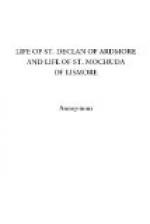Regarding the age of our “Life” it is difficult with the data at hand to say anything very definite. While dogmatism however is dangerous indefiniteness is unsatisfying. True, we cannot trace the genealogy of the present version beyond middle of the sixteenth century, but its references to ancient monuments existing at date of its compilation show it to be many centuries older. Its language proves little or nothing, for, being a popular work, it would be modernised to date by each successive scribe. Colgan was of opinion it was a composition of the eighth century. Ussher and Ware, who had the Life in very ancient codices, also thought it of great antiquity. Papebrach, the Bollandist, on the other hand, considered the Life could not be older than the twelfth century, but this opinion of his seems to have been based on a misapprehension. In the absence of all diocesan colour or allusion one feels constrained to assign the production to some period previous to Rathbreasail. We should not perhaps be far wrong in assigning the first collection of materials to somewhere in the eighth century or in the century succeeding. The very vigorous ecclesiastical revival of the eleventh century, at conclusion of the Danish wars, must have led to some revision of the country’s religious literature. The introduction, a century and-a-half later, of the great religious orders most probably led to translation of the Life into Latin and its casting into shape for reading in refectory or choir.
Only three surviving copies of the Irish Life are known to the writer: one in the Royal Library at Brussels, the second in the Royal Irish Academy Collection (M. 23, 50, pp. 109-120), and the third in possession of Professor Hyde. As the second and third enumerated are copies of one imperfect exemplar it has not been thought necessary to collate both with the Brussels Ms. which has furnished the text here printed. M. 23, 50 (R.I.A.) has however been so collated and the marginal references initialled B are to that imperfect copy. The latter, by the way, is in the handwriting of John Murphy “na Raheenach,” and is dated 1740. It has not been thought necessary to give more than the important variants.




